Grenada - Honeymoon Day 1

The flight into Porlamar, Isla Margarita, Venezuela was as comfortable as a nine-hour flight in economy class can be. The plane wasn't very full, and had a 2-4-2 seat configuration. Marga spent most of the time lying flat across the four seats in the middle trying to fight off her cold, waking occasionally to cough or blow her nose. Neither Marga nor I are very extroverted. We don't go up to people and introduce ourselves and start talking. I was amazed by the amount of social groups that had formed on the airplane before we even landed. Groups of couples were talking together about their weddings, etc. That was another strange thing. The majority of the people on the plane had gotten married on the same day we had, all throughout Spain. Only later did we discover that several of the groups of people had already met and talked to each other over the Internet in an online forum about the cruise.
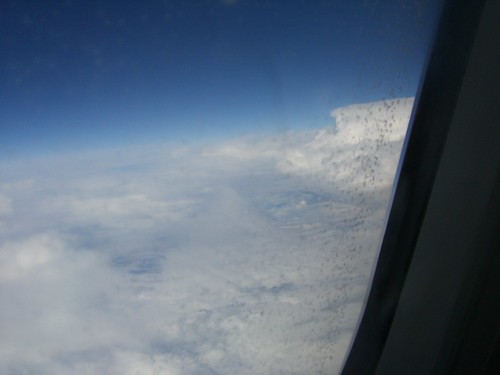
The only real turbulence we experienced was well announced and only lasted a few minutes. When I opened the window shade afterwards, I saw that we had passed through the top of a huge thunderhead. But by the time I got my camera out of the overhead compartment, it wasn't very visible.

The Caribbean is sprinkled with tons of little fluffy clouds.

There gazing out the window, I thought my ringed fist looked pretty cool.
When we landed and stepped out of the plane, we were hit with a huge wave of wet warmth. The humidity and heat that we would have for a fortnight was overwhelming at first. Marga, who is always cold and loves warm weather, was smiling from ear to ear.
A bunch of immigration forms and a bus ride later, we were carrying our bags to our cabin on the cruise ship. We had a brief walk around the ship, read some itinerary literature, had a margarita in a bar, and it was time for dinner. The dinner was okay, but I almost fell asleep in my soup. We skipped dessert and went straight to the cabin and collapsed into bed.

Having a margarita with Margarita on boat docked at Isla Margarita.
We were wide awake at 5:30 AM (which felt like almost noon to our bodies). We saw in the daily ship newsletter that the sunrise was at 6:00 AM, so we decided to go out on deck and watch it. The sunrise was somewhat less spectacular than I had hoped, with plenty of clouds on the eastern horizon. As we had our breakfast buffet out on deck, we arrived to the island of Grenada.
(most of what you read below was written during the trip, so please pardon tense changes)
Grenada
We knew zero about this little island nation when we stepped off the boat and headed for the tour bus. By complete luck, we were at the front of one of the line cuts to board the buses, and I got to sit in the front of the bus, just behind the driver. In Grenada, they drive on the left side of the road, speak English, have British electrical plugs, and are a member of the Commonwealth. They gained their independence from Britain in the late 70’s, and have since had a revolution, in the mid-80’s, which almost resulted in Communism, due to Cuba’s and Russia’s willingness to aid the rebels.

Docked.

Goofy cruise ship tourist.
Our cruise ship is filled almost entirely with Spaniards, with the odd Mexican or Venezuelan thrown in. Only one couple, that I’ve seen, does not speak Spanish, and require instructions in English. I think they are German. When the waiters and other people swipe my cruise ship card and see my nationality appear on their screen, they will often start speaking to me in English, but the vast majority of organizational documentation and communication is in Spanish.
So our tour guide, an attractive black woman in her 30s, gave the tour in Spanish. I’d say her Spanish was only slightly better than mine. But since I was sitting up front next to her and the driver, I could ask them a few questions in English every now and then. The driver spoke no Spanish at all.

Some shots from the tour bus.

We stopped at various places around the island, many of them up on mountains with spectacular views. At one stop, we had some problems because the road was blocked for a food festival that the town was having. When we finally got out, we got to walk around through the booths. They were selling the most common national dish, a food called “oil downâ€. It’s made with fruit and vegetables and whatever meat is available, colored yellow with saffron, and cooked for thirty minutes between some special native leaves. The smell was delicious, and if I’d had any US dollars on me, I would have bought some.
You see, the currency here is the Caribbean Dollar, about 2.6 of which is equal to one US dollar. But all shops accept US dollars. But very few of them will give you change in US dollars. Most of the touristy areas will also accept euro bills, but not coins. One place was selling water for either 2 USD or 4 EUR. This rightfully outraged the Spaniards. At one of the stops, there was a woman who would balance a huge basket of food on her head and let you take a photo of her for one US dollar. As we were leaving that stop, I had to help translate her plea with the Spaniards to trade three 1€ coins for 3 USD, a hell of a deal, but no one had any US ones.
At one stop, I saw a group of Spaniards gathered along a fence pointing into a nearby tree. I went to check it out and they said there were two monkeys in there. A native on the other side of the fence pulled out some cough drops and set them on the fence. He said that the monkeys really like hard candy. I muttered a “Yeah, right, like they’re gonna come get that from the fence,†and watched as the monkeys jumped on down from the tree, ran over and climbed up the fence right next to us, skillfully unwrapped the candy and swallowed them whole. One of them actually let me touch him and Marga was able to snap a photo with the two of us. That was my first physical contact with a non-human primate. His body felt kind of catlike, and once he grabbed my finger in his hand, which was pretty freaky.
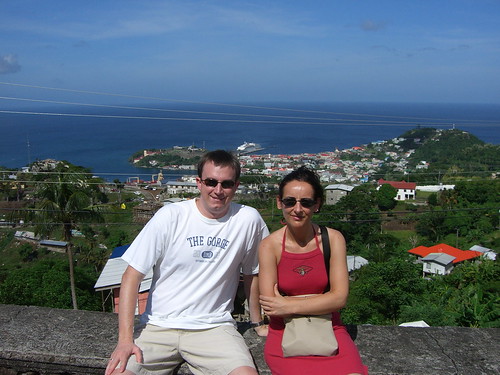
Up on a mountain overlooking a good portion of the island.

What a tiny boat we came in!

Panorama from the mountaintop fort.

This is what the majority of houses look like.
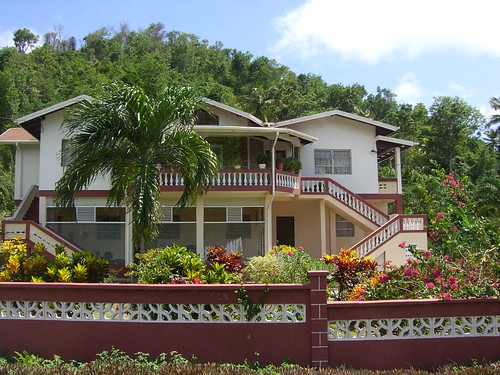
The owner of this dwelling must be quite rich.
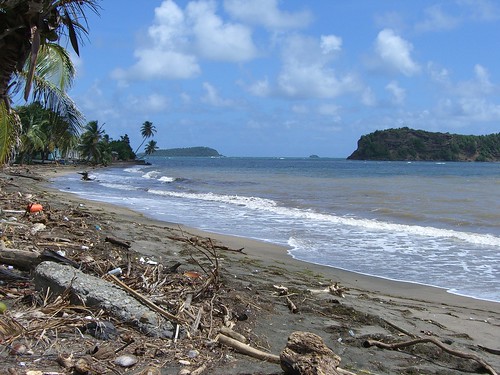
There were tons of beaches like this filled with garbage and general crap washed up from the sea.

This beach was a dark volcanic color.

Marga with a coconut.

The people lived in houses like this with trash all around. Gross.

The colors of the Grenada flag.
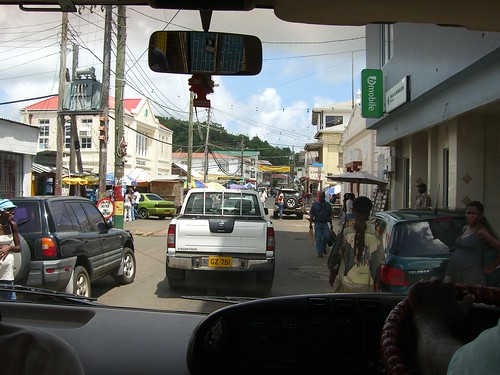
A general "driving around town" shot.

Fruit.

At a defunct nutmeg factory we toured.

The tour guide cracked some of these guys open, and the smell was wonderful! Go to your spice rack and take a whiff.
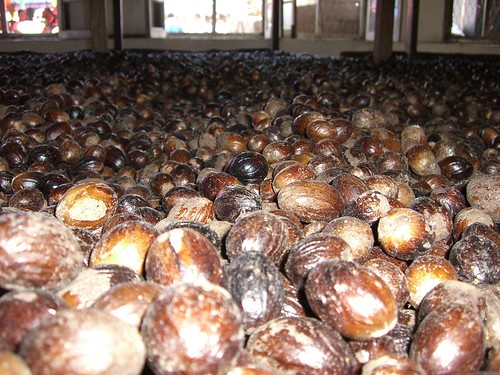

Please wear your dog mask at all times.

Oh my god! The giant African snails! They're everywhere! Run!!! Well, okay, you can walk, saunter, or meander away from them if you want.

Fat white tourists posing for photos with the skinny black natives.
That was kind of a joke, but I didn't recognize and specifically mention to Marga that there was absolutely no obesity in Grenada.

Fresh from the plantaintion. Har har.

Yummy fruit for sale.
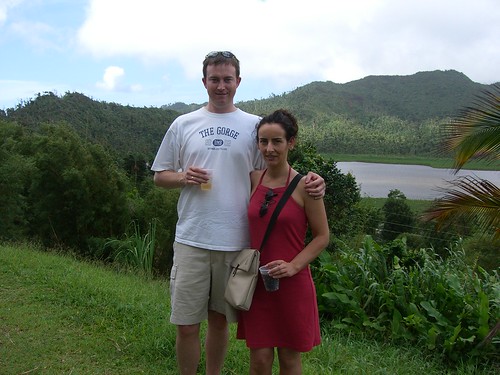
Enjoying a free drink at Grand Etang Lake, volcanic in origin, long thought to be bottomless, until science came along and answered the question.

Grand Etang Lake Panorama. See in Google Maps.

A nice view from the porch of a tiny little house now used as a museum info center about the lake and island in general.
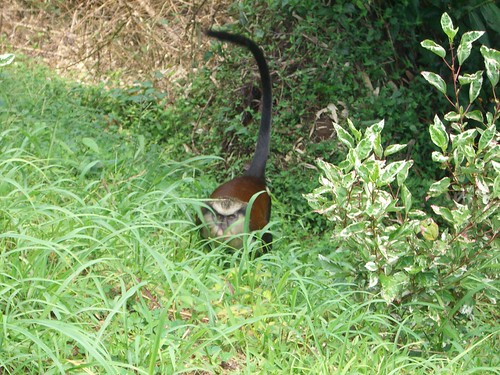
Monkey business.

Hey, hey, we're the monkeys!
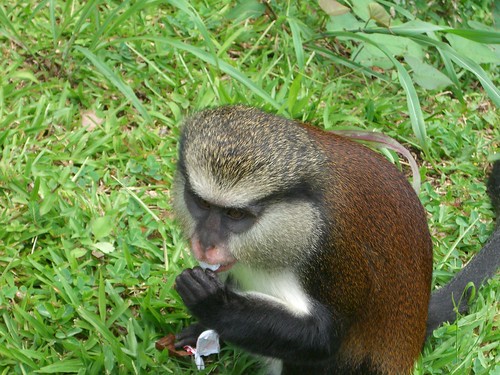
Little pea-sized primate brain can't handle the concept of a lozenge.
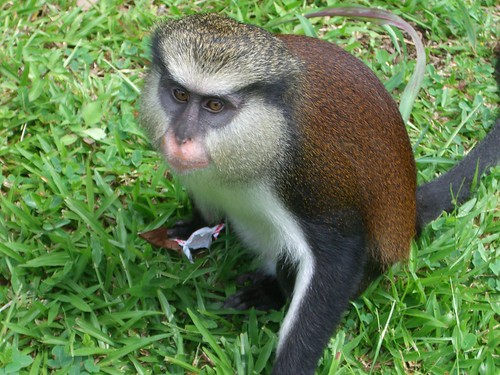
Gulp! I wonder if they come out solid at the other end.

Up on the railing next to us. (don't worry, there's only one more monkey picture to go!)

A pair of monkeys not smart enough to look at the camera.
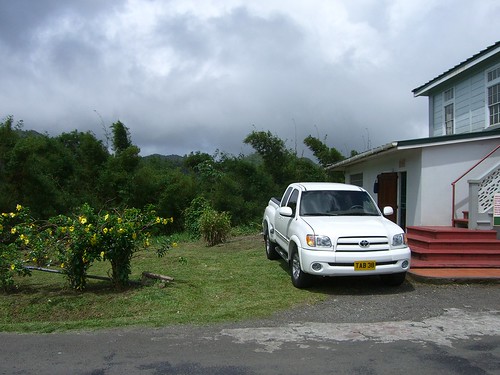
I got a kick out of the number of letters and digits they needed to uniquely identify vehicles with license plates.

At another stop, we entered a bit of jungle to see a waterfall.

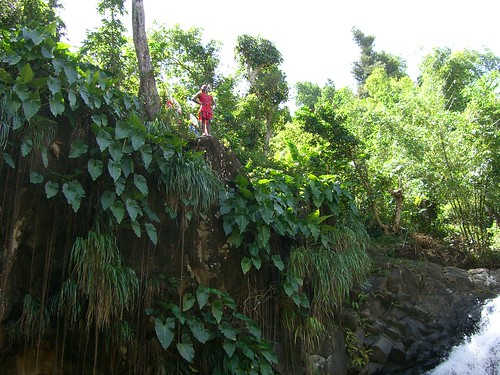
There was a group of young men that spent their days jumping off a cliff into the waterfall and then asking tourists for tips. Not a bad job, if you ask me.

Obligatory waterfall shot.

Some pretty funky plants in the jungle.

Pods of some sort, apparently.

Take only photos, leave only footprints.

The cloud formations in the Caribbean were unlike anything I've seen further north. There were tons of these tall towering cumulonimbi. Normally a vertically tall cloud means rain or a storm, but not so much down there.
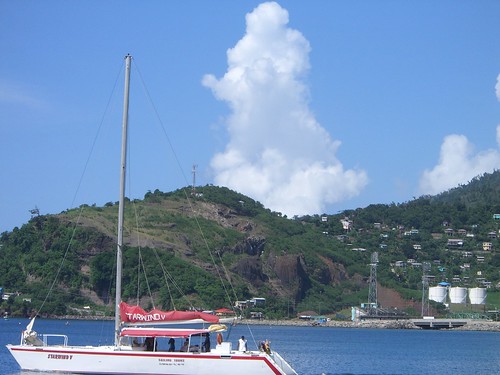

Climbing the stairs to the cruise ship. The company was Pullmantur.

I rightly figured I should take some photos of the cabin at the beginning of the cruise while it was still neat and tidy.
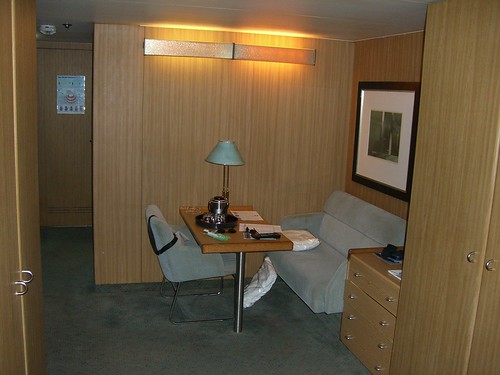
Our cabin was interior (no window), but it was much larger than I expected. We saved quite a bit of money by accepting individual beds rather than requesting a double.
Eventually, we made it back to the ship, said good-bye to our guide, Sinita, and driver, Michael, and went to have lunch. I had a cold soup of mango, which was mediocre, and a plate of lamb and eggplant with feta cheese that was pretty fantastic. After lunch, although feeling like a siesta, we headed back out to wander around the town we were docked in. During the bus tour that morning, several times we had the sensation that it would be nice to be walking around rather than in a bus.
Upon leaving the little mall that they make cruise passengers walk through, a friendly fellow in his early 20s came up to us, introduced himself as Roger, and said he would love to walk around with us and tell us about different places in the city. He was very friendly and persistent, but we finally got rid of him. We walked up some hills, saw an old crumbling church, walked down to some other docks and saw the public library. We entered the public library and were stopped by the librarian. She said that Marga, in her sleeveless dress with straps, did not fit the library dress code. I was welcome to walk around, but Marga would have to wait outside. So we left.
Since I’ve never been to Africa, it was a fairly new experience for me to be in the tiny, tiny minority because of my skin color. I felt very...conspicuous. One guy asked us, “How do you like Grenada?†in a cheerful voice. And a few taxis honked at us to see if we wanted a ride.
According to our tour guide in the morning, there is little to no crime in Grenada. The entire country has a couple murders a year, very little crime, and only one small jail. And almost all the crime is caused by people who have spent time in other countries. People don’t lock their doors at night, and everyone generally respects everyone else. During out afternoon walk around town, we sat on a bench to observe the local population. If there’s one thing they don’t have in Grenada, it’s haste. Absolutely no one was in a hurry to get anywhere. Everyone sauntered along leisurely.
The main product of Grenada is spices, especially nutmeg and cinnamon. It seems ironic that spices, from India, were Columbus’ main reason for heading west. We visited a now defunct nutmeg factory and saw the process of breaking the nuts to make the spice. Back in the 90’s, hurricane Ivan came through and knocked out 90% of the crops and destroyed almost all the houses. Then, a few years later, another hurricane came through and knocked out 80% of what was left. So they had to start fresh from 2% of their farm land. This displaced a lot of the farmers towards the cities trying to find work. The lowest paid people are the farm workers, who make 25 Caribbean bucks a day for doing 3 hours of work. Apparently the work day for most people is pretty short. In general, the population struck us as pretty lazy. There were lots of buildings that were run down, paint peeling, tiles broken, etc., and I don’t think the entire reason for this was for lack of money. Marga hypothesized that, if you live in a place where the food you need each day is right there on the trees above you, it’s harder to build a work ethic than if you are forced by survival necessity to slave in the fields all day. We passed one building with broken windows and a hole in the roof that Marga identified as an abattoir, probably from the meat hooks and hanging animal hides. I said that the place couldn’t possibly still be operational, but Marga’s eye noticed that the floor, at least, was very clean, and she figured it was still functional. We asked a neighboring shop clerk and he confirmed that they do slaughter cattle, sheep, goats, and pigs there every Friday. Pretty amazing.

An old church.
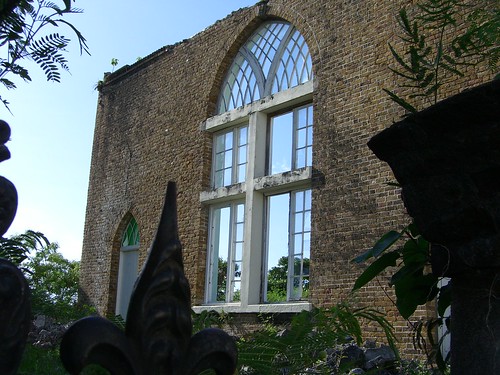
Hard to tell if you're on the inside or the outside of this wall.

Chilling out in Grenada. No hurries, no worries.
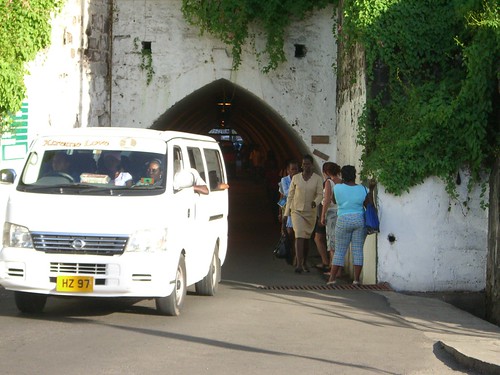
The only tunnel in Grenada. The pedestrians walk right through there with the cars. It was quite a claustrophobic 80 meters to walk.

The slaughterhouse.

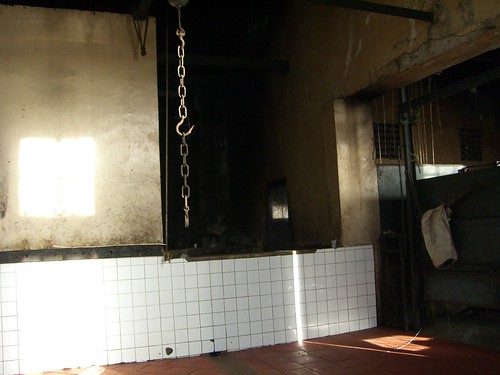
Thank god we didn't order any meat on the island.
In general, we liked Grenada very much. We might not want to live there, despite that fact that we could live pretty sweetly there on just my salary. It was the island most culturally different from Europe that we visited in the whole trip. The temperature is always between 25C and 30C (80F and 90F) and it rains more from August to December. But beyond that, the weather doesn’t change. Down at the equator, the sun rises and sets at almost exactly 6:00, producing repeating 12-hour days and nights.
Up next: Barbados!